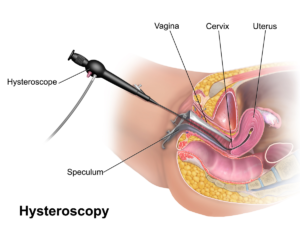What is a hysteroscopy?
Hysteroscopy is a procedure that can be used to both diagnose and treat causes of abnormal bleeding. The procedure allows your doctor to look inside your uterus with a tool called a hysteroscope. This is a thin, lighted tube that is inserted into the vagina to examine the cervix and inside of the uterus. Hysteroscopy can be a part of the diagnosis process or an operative procedure.
When should hysteroscopy be performed?
Your doctor may recommend scheduling the hysteroscopy for the first week after your menstrual period. This timing will provide the doctor with the best view of the inside of your uterus. Hysteroscopy is also performed to determine the cause of unexplained bleeding or spotting in postmenopausal women.
How is hysteroscopy performed?
Prior to the procedure, your doctor may prescribe a sedative to help you relax. You will then be prepared for anesthesia. The procedure itself takes place in the following order:
- The doctor will dilate (widen) your cervix to allow the hysteroscope to be inserted.
- The hysteroscope is inserted through your vagina and cervix into the uterus.
- Carbon dioxide gas or a liquid solution is then inserted into the uterus, through the hysteroscope, to expand it and to clear away any blood or mucus.
- Next, a light shone through the hysteroscope allows your doctor to see your uterus and the openings of the fallopian tubes into the uterine cavity.
- Finally, if surgery needs to be performed, small instruments are inserted into the uterus through the hysteroscope.
The time it takes to perform hysteroscopy can range from less than five minutes to more than an hour. The length of the procedure depends on whether it is diagnostic or operative and whether an additional procedure, such as laparoscopy, is done at the same time. In general, however, diagnostic hysteroscopy takes less time than operative.
RISKS / BENEFITS
What are the benefits of hysteroscopy?
Compared with other, more invasive procedures, hysteroscopy may provide the following advantages:
- Shorter hospital stay.
- Shorter recovery time.
- Less pain medication needed after surgery.
- Avoidance of hysterectomy.
- Possible avoidance of “open” abdominal surgery.
How safe is hysteroscopy?
Hysteroscopy is a relatively safe procedure. However, as with any type of surgery, complications are possible. With hysteroscopy, complications occur in less than 1% of cases and can include:
- Risks associated with anesthesia.
- Infection.
- Heavy bleeding.
- Injury to the cervix, uterus, bowel or bladder.
- Intrauterine scarring.
- Reaction to the substance used to expand the uterus.

